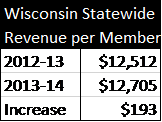In Kansas Prioritizes Tax Cuts Over Kids, KCEG says a reduction in state revenue has caused cuts to education and attempts to send the message that not making even bigger ‘investments’ in education means the State doesn’t care about student outcomes. To solidify that contention by making it appear universal, KCEG points to Wisconsin as another state that cut taxes (income and property taxes) and likewise, aid to education. But as it turns out, the only thing these assertions have in common is that neither is based in reality. Here is how their false allegations stack up to the facts.
1. KCEG claim: Kansas general aid per pupil is down 2.6% (about $129) between 2013 and 2014, a percentage that is proportionate to reduction in state revenues.
Fact: According to the Kansas Department of Education website (official data) “General State Aid Per Pupil” (a KSDE definition) INCREASED $13 between 2013 and 2014 as shown in the table below (and all aid per pupil increased $179).

2. KCEG claim: Wisconsin cut taxes which led to cuts in education spending. General aid per pupil was cut by $36 from 2013 to 2014.
Fact: A quick look at the Wisconsin Department of Public Instruction website indicates that statewide revenue per pupil (they use the term “member”) shows an INCREASE of $193 between 2013 and 2014 as shown in the table below.

And here is another fact that KCEG conveniently omitted: 2013-14 was the second consecutive year of record funding in Kansas K-12 education with $12,959 per pupil, which totals nearly $6 billion in revenue. That trend will continue with the new block grant education funding set to start next year. As KPI pointed out in this blog, total funding to education is poised to set yet another record in 2015-16.
So much for letting the truth get in the way of a highly charged contention.
KCEG relied on tax revenue data from the Rockefeller Institute of Government (RIG) and education spending data from a study by the Center for Budget and Public Policy (CBPP) to make their claims. KPI reached out to KCEG, RIG, and CBPP to source and verify their data. We received no response from KCEG or CBPP, but the director of RIG stated the 2.6% reduction in revenues was likely a misinterpretation of their data. So, instead of citing original source data from Kansas state government agencies, KCEG chose to cherry-pick and manipulate data from outside sources in order to fit their narrative. And that narrative includes the false choice that lower government spending automatically precipitates a lower quality of service. By the way, CBPP is also notorious for making false and unsubstantiated claims; see here and here for examples.
KCEG has even gone a step farther by turning this mantra into a scare tactic. They declare less money will lead to lower educational outcomes because there will be less money to the classroom. So why are the students/teachers/classroom always the targets of the fear mongers? Why always the threat of teacher layoffs? Why not administrators? Could it be that it’s not as emotionally compelling to say an assistant principal, or a curriculum director, or even a communications officer may be let go? It is well documented that schools choose not to operate efficiently, so it’s always the students who are made human budget shields.
The idea that more money leads to better outcomes simply does not stand up to scrutiny. Much has been written to discredit that claim. Perhaps this quote from a Heritage Foundation study says it best: “Continuous spending increases have not corresponded with equal improvement in American educational performance.” NAEP reading and math scores have remained flat, as have ACT scores, and quoting KCEG in a different context: “[W]e don’t have to go any further than our own backyard to see that.”
Perhaps it’s time KCEG just acknowledge their affinity for high taxes and ineffective spending and stop pretending to present data-driven conclusions.
KPI has a history or reaching out to KCEG to have a public discussion on the issues. We again welcome that chance to provide the facts about education spending so Kansans can come to their own conclusions. We invite and are willing to host KCEG to an open debate on this issue.




